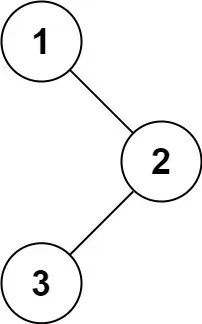文章目录
- 94. 二叉树的中序遍历:
- 样例 1:
- 样例 2:
- 样例 3:
- 提示:
- 分析:
- 题解:
- rust:
- go:
- c++:
- python:
- java:
94. 二叉树的中序遍历:
给定一个二叉树的根节点 root ,返回 它的 中序 遍历 。
样例 1:

输入:
root = [1,null,2,3]
输出:
[1,3,2]
样例 2:
输入:
root = []
输出:
[]
样例 3:
输入:
root = [1]
输出:
[1]
提示:
- 树中节点数目在范围
[0, 100]内 -100 <= Node.val <= 100
分析:
- 面对这道算法题目,二当家的再次陷入了沉思。
- 二叉树的中序遍历和前序遍历,后续遍历是二叉树常用的遍历方式。
- 使用递归方式比循环非递归方式更加简单,直观,易于理解。
- 通常二叉树的中序遍历一定要使用一个栈结构,因为中序遍历的要求是遍历完左子树才能遍历当前节点,但是遍历到了左子树就无法再回到当前节点了,所以一般都是使用压栈的方式,先将当前节点压栈,遍历完左子树再将当前节点出栈,这样空间复杂度就会是 O(n) (递归也相当于使用了栈结构)。
- 说起来这不是什么大问题,但是算法就是要想办法优化降低时间和空间的复杂度,于是寄出一种可以将空间复杂度降低为 O(1) 的中序遍历方式,Morris 中序遍历。
- 事实上Morris 中序遍历不是没有代价的,由于要做额外的节点连接和恢复,相当于用时间换空间。
题解:
rust:
// Definition for a binary tree node.
// #[derive(Debug, PartialEq, Eq)]
// pub struct TreeNode {
// pub val: i32,
// pub left: Option<Rc<RefCell<TreeNode>>>,
// pub right: Option<Rc<RefCell<TreeNode>>>,
// }
//
// impl TreeNode {
// #[inline]
// pub fn new(val: i32) -> Self {
// TreeNode {
// val,
// left: None,
// right: None
// }
// }
// }
use std::rc::Rc;
use std::cell::RefCell;
impl Solution {
pub fn inorder_traversal(mut root: Option<Rc<RefCell<TreeNode>>>) -> Vec<i32> {
let mut ans = Vec::new();
while root != None {
if root.as_ref().unwrap().borrow().left != None {
// 寻找当前 root 节点的前驱节点:前驱 predecessor 节点就是当前 root 节点向左走一步,然后一直向右走至无法走为止
let mut predecessor = root.as_ref().unwrap().borrow().left.clone();
while predecessor.as_ref().unwrap().borrow().right != None
&& predecessor.as_ref().unwrap().borrow().right != root {
predecessor = predecessor.unwrap().borrow().right.clone();
}
if predecessor.as_ref().unwrap().borrow().right == None {
// 让前驱 predecessor 节点的右指针指向当前 root 节点,继续遍历左子树,之后会再次回到当前 root 节点
predecessor.unwrap().borrow_mut().right = root.clone();
// 遍历左子树
root = root.unwrap().borrow().left.clone();
continue;
} else {
// 左子树遍历完毕又回到了当前 root 节点,让前驱 predecessor 节点的右指针与当前 root 节点断开,恢复原样
predecessor.unwrap().borrow_mut().right = None;
}
}
// 遍历当前 root 节点
ans.push(root.as_ref().unwrap().borrow().val);
// 遍历当前 root 节点的右子树
root = root.unwrap().borrow().right.clone();
}
return ans;
}
}
go:
/**
* Definition for a binary tree node.
* type TreeNode struct {
* Val int
* Left *TreeNode
* Right *TreeNode
* }
*/
func inorderTraversal(root *TreeNode) []int {
var ans []int
for root != nil {
if root.Left != nil {
// 寻找当前 root 节点的前驱节点:前驱 predecessor 节点就是当前 root 节点向左走一步,然后一直向右走至无法走为止
predecessor := root.Left
for predecessor.Right != nil && predecessor.Right != root {
// 有右子树且没有设置过指向 root,则继续向右走
predecessor = predecessor.Right
}
if predecessor.Right == nil {
// 让前驱 predecessor 节点的右指针指向当前 root 节点,继续遍历左子树,之后会再次回到当前 root 节点
predecessor.Right = root
// 遍历左子树
root = root.Left
continue
} else {
// 左子树遍历完毕又回到了当前 root 节点,让前驱 predecessor 节点的右指针与当前 root 节点断开,恢复原样
predecessor.Right = nil
}
}
// 遍历当前 root 节点
ans = append(ans, root.Val)
// 遍历当前 root 节点的右子树
root = root.Right
}
return ans
}
c++:
/**
* Definition for a binary tree node.
* struct TreeNode {
* int val;
* TreeNode *left;
* TreeNode *right;
* TreeNode() : val(0), left(nullptr), right(nullptr) {}
* TreeNode(int x) : val(x), left(nullptr), right(nullptr) {}
* TreeNode(int x, TreeNode *left, TreeNode *right) : val(x), left(left), right(right) {}
* };
*/
class Solution {
public:
vector<int> inorderTraversal(TreeNode* root) {
vector<int> ans;
while (root != nullptr) {
if (root->left != nullptr) {
// 寻找当前 root 节点的前驱节点:前驱 predecessor 节点就是当前 root 节点向左走一步,然后一直向右走至无法走为止
TreeNode *predecessor = root->left;
while (predecessor->right != nullptr && predecessor->right != root) {
predecessor = predecessor->right;
}
if (predecessor->right == nullptr) {
// 让前驱 predecessor 节点的右指针指向当前 root 节点,继续遍历左子树,之后会再次回到当前 root 节点
predecessor->right = root;
// 遍历左子树
root = root->left;
continue;
} else {
// 左子树遍历完毕又回到了当前 root 节点,让前驱 predecessor 节点的右指针与当前 root 节点断开,恢复原样
predecessor->right = nullptr;
}
}
// 遍历当前 root 节点
ans.emplace_back(root->val);
// 遍历当前 root 节点的右子树
root = root->right;
}
return ans;
}
};
python:
# Definition for a binary tree node.
# class TreeNode:
# def __init__(self, val=0, left=None, right=None):
# self.val = val
# self.left = left
# self.right = right
class Solution:
def inorderTraversal(self, root: Optional[TreeNode]) -> List[int]:
ans = list()
while root is not None:
if root.left is not None:
# 寻找当前 root 节点的前驱节点:前驱 predecessor 节点就是当前 root 节点向左走一步,然后一直向右走至无法走为止
predecessor = root.left
while predecessor.right is not None and predecessor.right != root:
# 有右子树且没有设置过指向 root,则继续向右走
predecessor = predecessor.right
if predecessor.right is None:
# 让前驱 predecessor 节点的右指针指向当前 root 节点,继续遍历左子树,之后会再次回到当前 root 节点
predecessor.right = root
# 遍历左子树
root = root.left
continue
else:
# 左子树遍历完毕又回到了当前 root 节点,让前驱 predecessor 节点的右指针与当前 root 节点断开,恢复原样
predecessor.right = None
# 遍历当前 root 节点
ans.append(root.val)
# 遍历当前 root 节点的右子树
root = root.right
return ans
java:
/**
* Definition for a binary tree node.
* public class TreeNode {
* int val;
* TreeNode left;
* TreeNode right;
* TreeNode() {}
* TreeNode(int val) { this.val = val; }
* TreeNode(int val, TreeNode left, TreeNode right) {
* this.val = val;
* this.left = left;
* this.right = right;
* }
* }
*/
class Solution {
public List<Integer> inorderTraversal(TreeNode root) {
List<Integer> ans = new ArrayList<Integer>();
while (root != null) {
if (root.left != null) {
// 寻找当前 root 节点的前驱节点:前驱 predecessor 节点就是当前 root 节点向左走一步,然后一直向右走至无法走为止
TreeNode predecessor = root.left;
while (predecessor.right != null && predecessor.right != root) {
predecessor = predecessor.right;
}
if (predecessor.right == null) {
// 让前驱 predecessor 节点的右指针指向当前 root 节点,继续遍历左子树,之后会再次回到当前 root 节点
predecessor.right = root;
// 遍历左子树
root = root.left;
continue;
} else {
// 左子树遍历完毕又回到了当前 root 节点,让前驱 predecessor 节点的右指针与当前 root 节点断开,恢复原样
predecessor.right = null;
}
}
// 遍历当前 root 节点
ans.add(root.val);
// 遍历当前 root 节点的右子树
root = root.right;
}
return ans;
}
}
非常感谢你阅读本文~
欢迎【点赞】【收藏】【评论】三连走一波~
放弃不难,但坚持一定很酷~
希望我们大家都能每天进步一点点~
本文由 二当家的白帽子:https://le-yi.blog.csdn.net/ 博客原创~
文章出处登录后可见!
已经登录?立即刷新
